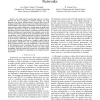Free Online Productivity Tools
i2Speak
i2Symbol
i2OCR
iTex2Img
iWeb2Print
iWeb2Shot
i2Type
iPdf2Split
iPdf2Merge
i2Bopomofo
i2Arabic
i2Style
i2Image
i2PDF
iLatex2Rtf
Sci2ools
GLOBECOM
2007
IEEE
2007
IEEE
Cooperative Beamforming for Wireless Ad Hoc Networks
—Via collaborative beamforming, nodes in a wireless network are able to transmit a common message over long distances in an energy efficient fashion. However, the process of making available the same message to all collaborating nodes introduces delays. In this paper, a MAC-PHY cross-layer scheme is proposed that enables collaborative beamforming at significantly reduced collaboration overhead. It consists of two phases. In the first phase, nodes transmit locally in a random access time-slotted fashion. Simultaneous transmissions from multiple source nodes are viewed as linear mixtures of all transmitted packets. In the second phase, a set of collaborating nodes, acting as a distributed antenna system, beamform the received analog waveform to one or more faraway destinations. This step requires multiplication of the received analog waveform by a complex weight, which is independently computed by each cooperating node, and which allows packets bound to the same destination to add c...
Analog Waveform | Communications | Enables Collaborative Beamforming | GLOBECOM 2007 | Multiple Source Nodes |
| Added | 07 Dec 2010 |
| Updated | 07 Dec 2010 |
| Type | Conference |
| Year | 2007 |
| Where | GLOBECOM |
| Authors | Lun Dong, Athina P. Petropulu, H. Vincent Poor |
Comments (0)

